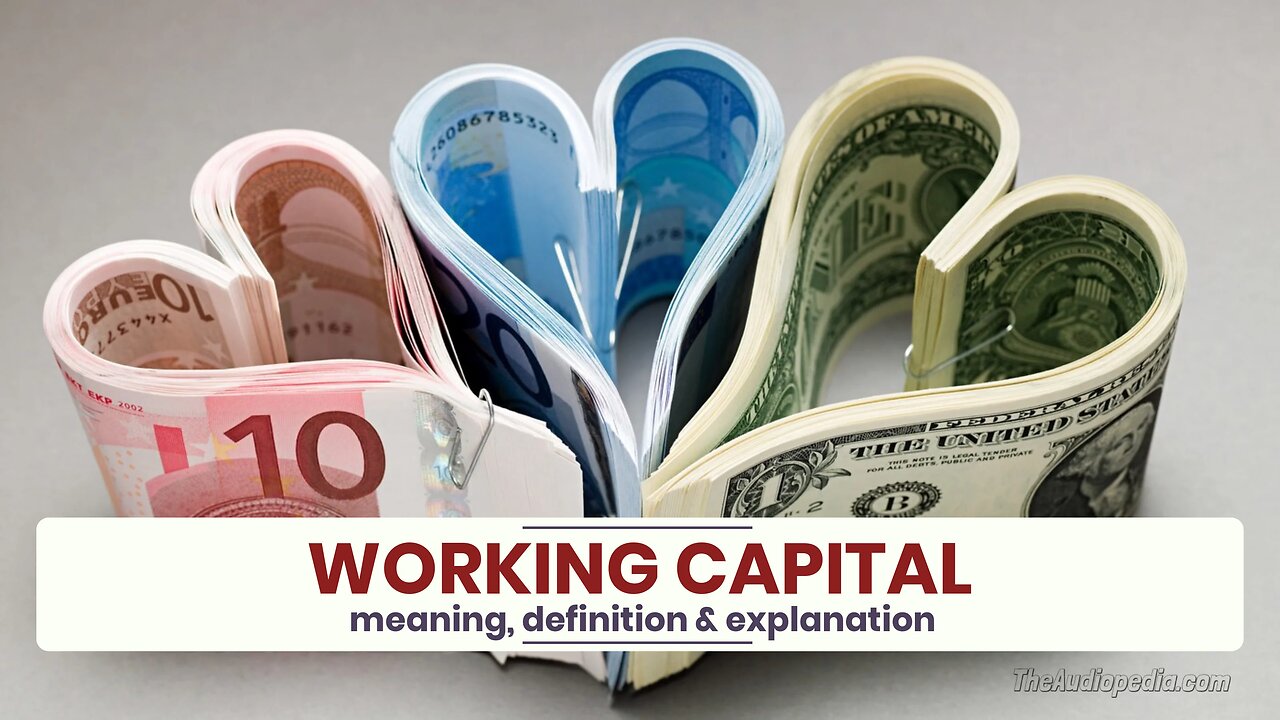Premium Only Content

What is WORKING CAPITAL?
✪✪✪✪✪
http://www.theaudiopedia.com
✪✪✪✪✪
What does WORKING CAPITAL mean? WORKING CAPITAL meaning - WORKING CAPITAL definition - WORKING CAPITAL explanation. What is the meaning of WORKING CAPITAL? What is the definition of WORKING CAPITAL? What does WORKING CAPITAL stand for? What is WORKING CAPITAL meaning? What is WORKING CAPITAL definition?
Working capital is the amount of funds which are necessary to an organization to continue its ongoing business operations, until the firm is reimbursed through payments for the goods or services it has delivered to its customers. Working capital is measured through the difference between resources in cash or readily convertible into cash (Current Assets), and cash requirements (Current Liabilities). As a result, capital resource allocations relating to working capital are always current, i.e. short-term. In addition to time horizon, working capital management differs from capital budgeting in terms of discounting and profitability considerations; they are also "reversible" to some extent. (Considerations as to Risk appetite and return targets remain identical, although some constraints – such as those imposed by loan covenants – may be more relevant here).
The (short term) goals of working capital are therefore not approached on the same basis as (long term) profitability, and working capital management applies different criteria in allocating resources: the main considerations are (1) cash flow / liquidity and (2) profitability / return on capital (of which cash flow is probably the most important).
The most widely used measure of cash flow is the net operating cycle, or cash conversion cycle. This represents the time difference between cash payment for raw materials and cash collection for sales. The cash conversion cycle indicates the firm's ability to convert its resources into cash. Because this number effectively corresponds to the time that the firm's cash is tied up in operations and unavailable for other activities, management generally aims at a low net count. (Another measure is gross operating cycle which is the same as net operating cycle except that it does not take into account the creditors deferral period.)
In this context, the most useful measure of profitability is Return on capital (ROC). The result is shown as a percentage, determined by dividing relevant income for the 12 months by capital employed; Return on equity (ROE) shows this result for the firm's shareholders. As above, firm value is enhanced when, and if, the return on capital exceeds the cost of capital.
Guided by the above criteria, management will use a combination of policies and techniques for the management of working capital. These policies aim at managing the current assets (generally cash and cash equivalents, inventories and debtors) and the short term financing, such that cash flows and returns are acceptable.
Cash management. Identify the cash balance which allows for the business to meet day to day expenses, but reduces cash holding costs.
Inventory management. Identify the level of inventory which allows for uninterrupted production but reduces the investment in raw materials – and minimizes reordering costs – and hence increases cash flow. Note that "inventory" is usually the realm of operations management: given the potential impact on cash flow, and on the balance sheet in general, finance typically "gets involved in an oversight or policing way".:714 See Supply chain management; Just In Time (JIT); Economic order quantity (EOQ); Dynamic lot size model; Economic production quantity (EPQ); Economic Lot Scheduling Problem; Inventory control problem; Safety stock.
Debtors management. There are two inter-related roles here: Identify the appropriate credit policy, i.e. credit terms which will attract customers, such that any impact on cash flows and the cash conversion cycle will be offset by increased revenue and hence Return on Capital (or vice versa); see Discounts and allowances. Implement appropriate Credit scoring policies and techniques such that the risk of default on any new business is acceptable given these criteria.
Short term financing. Identify the appropriate source of financing, given the cash conversion cycle: the inventory is ideally financed by credit granted by the supplier; however, it may be necessary to utilize a bank loan (or overdraft), or to "convert debtors to cash" through "factoring".
-
 2:28
2:28
The Audiopedia
1 year agoWhat is MORTGAGE BROKER?
22 -
 9:44
9:44
Millionaire Mentor
3 days agoCharlie Kirk Brings Woke Student To STUTTERING Over White Privilege Lies
1535 -
 24:12
24:12
MudandMunitions
8 hours agoOff-Roading with NYPrepper Wild Elk & PA’s Most Remote Backroads
23 -
 LIVE
LIVE
Bannons War Room
7 months agoWarRoom Live
4,613 watching -
 LIVE
LIVE
IsaiahLCarter
7 hours agoAPOSTATE RADIO 029: Leftist Violence, & NYC's Mayor's Race (Guests: Lattina Brown and David Sivella)
63 watching -
 10:03:41
10:03:41
LFA TV
14 hours agoLIVE: CHARLIE KIRK VIGIL SERVICE!
162K60 -
 6:59:16
6:59:16
BaldBrad
9 hours agoCharlie Kirk Memorial LIVESTREAM
26.8K3 -
 5:13:13
5:13:13
Professor Nez
1 day ago🚨Charlie Kirk Funeral LIVE: Trump Honors Kirk in Arizona 🇺🇸
24.8K14 -
 22:13
22:13
iCkEdMeL
10 hours ago $12.98 earnedMass Shooting at Wedding Reception — Witnesses Say Shooter Yelled “Free Palestine”
127K43 -
 0:36
0:36
Danny Rayes
2 days ago $5.28 earnedFacebook Needs To Be Stopped...
103K21